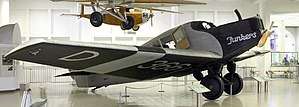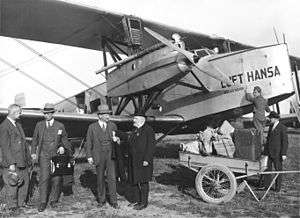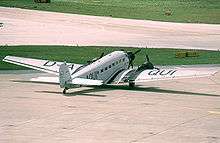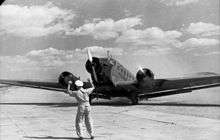Deutsche Luft Hansa
Deutsche Luft Hansa A.G. (from 1933 styled as Deutsche Lufthansa and also known as Luft Hansa, Lufthansa, or DLH) was a German airline, serving as flag carrier of the country during the later years of the Weimar Republic and throughout Nazi Germany.
 | |
| Founded | 1926 |
|---|---|
| Ceased operations | 1945 |
| Hubs | Berlin Tempelhof Airport |
| Headquarters | Berlin, Germany |
Even though Deutsche Luft Hansa was the forerunner of modern German airline Lufthansa (founded in 1953), there is no legal connection between the two.
History
1920s

Deutsche Luft Hansa was founded on 6 January 1926 in Berlin. The name of the company means "German Hansa of the Air". The Hansa or Hanseatic League dominated maritime trade in the Baltic Sea area for hundreds of years, and is well regarded in Germany to this day. The airline was created by the merger of Deutscher Aero Lloyd, formerly Deutsche Luft-Reederei, and Junkers Luftverkehr.[1] The two companies, Germany's largest airlines at the time, were forced to merge by the German government, while all other airlines were shut down. This reorganization was intended to reduce the amount of financial support the government provided to the airline industry. Like many other countries, Germany subsidized the airlines, which also gave the German government control over them.
The stylised flying crane symbol had been used by DLR and Deutscher Aero Lloyd.

The foundation of the airline coincided with the lifting of restrictions on commercial air operations imposed on Germany by the Treaty of Versailles. This allowed the route network to be quickly expanded to cover major European cities. The initial fleet consisted of 162 aircraft, nearly all of them outdated World War I types, and the company had 1,527 staff. The most important airfield for DLH was Berlin Tempelhof. From there a Fokker F.II took off on 6 April 1926 for the first scheduled flight to Zürich via Halle, Erfurt and Stuttgart. In the same year, Deutsche Luft Hansa acquired a stake in Deruluft, a joint German-Soviet airline, and launched non-stop flights from Berlin to Moscow, which was then regarded as an exceptionally long distance. Shortly after that flights to Paris were commenced. Deutsche Luft Hansa was one of the first airlines to operate night flights, the first of which connected Berlin with Königsberg using Junkers G 24 aircraft. This route proved so successful that the night train connection was discontinued some years later. During its first year, the airline operated more than six million flight kilometres, transporting a total of 56,268 passengers and 560 tons of freight and mail.
Over the following years, the domestic network grew to cover all the important cities and towns of Germany. More international routes were added through co-operation agreements. With the newly founded Iberia in Spain its longest scheduled route was 2,100 kilometres from Berlin to Madrid (though with several stopovers). The establishment of Syndicato Condor in Brazil served the airline's interests in South America where there were important German minorities at that time. The first East-West crossing of the North Atlantic Ocean (from Baldonnel Aerodrome in Ireland to Greenly Island, Canada) was made by the Luft Hansa pilot Hermann Köhl, Ehrenfried Günther Freiherr von Hünefeld and the Irish pilot James Fitzmaurice using the Junkers W 33 aircraft Bremen in April 1928. The airline launched scheduled multi-leg flights to Tokyo. A Heinkel HE 12 aircraft was launched (by catapult) off the NDL liner Bremen during her maiden voyage crossing the Atlantic in 1929, shortening the mail delivery time between Europe and North America. Both the Bremen and her sister ship Europa launched mail planes on their scheduled North Atlantic crossings until 1935.
1930s


Even though the early years of the decade saw a difficult financial situation due to the Great Depression, Deutsche Luft Hansa further expanded its international route network in South America, and launched scheduled flights from Germany to the Middle East. Politically, the company leaders were linked to the rising Nazi Party; an aircraft was made available to Adolf Hitler for his campaign for the 1932 presidential election free of any charge. Erhard Milch, who had served as head of the airline since 1926, became a high-ranking official at the Aviation Ministry when Hitler came to power in 1933.
A key interest of Deutsche Luft Hansa at that time was the reduction of mail delivery times. In 1930, the Eurasia Corporation was established as a joint-venture with the Chinese transport ministry, granting Luft Hansa a monopoly position for mail transport between Germany and China, as well as access to the Chinese market. To this end, the Shanghai-Nanjing-Beijing route was launched in the following year using Junkers W 34 specially deployed there. A record was set in 1930 when the mail route from Vienna to Istanbul (with stopovers in Budapest, Belgrad and Sofia) was completed in only 24 hours. By comparison, the first transatlantic passenger flight by the airline (from Warnemünde to New York City using a Dornier Wal flying boat) took roughly one week.
After several years of testing, a scheduled postal route between Europe and South America was inaugurated in 1934. This was the first regularly scheduled airline service across an ocean in the world. Wal flying boats were used, catapult launched for the trans-Atlantic leg[2] These were replaced by the Dornier Do 18 in 1936 making operations in non-visual conditions possible. The European network saw the introduction of the Junkers G.38 (at that time the largest passenger aircraft in the world) on the Berlin-London route via Amsterdam, as well as the Junkers Ju 52/3m and Heinkel He 70, which allowed for faster air travel. This was promoted by so-called "Blitz Services" (German: Blitzstrecken) between Berlin, Hamburg, Cologne and Frankfurt. In 1935, the first aircraft not manufactured in Germany were introduced into the Luft Hansa fleet: two Boeing 247s and one Douglas DC-2.
The grip on the domestic South American markets was further tightened in 1937, when the Sociedad Ecuatoriana de Transportes Aéreos (SEDTA)[3] and Lufthansa Perú were founded as Luft Hansa co-operations in Ecuador and Peru respectively, operating Junkers W 34 aircraft. The Middle Eastern network was expanded with the launch of the Berlin-Baghdad-Tehran route in the same year. In 1938 the Focke-Wulf Fw 200 long range aircraft was introduced making it possible to fly non-stop between Berlin and New York and from Berlin to Tokyo with only one intermediate stopover. This last year prior to the outbreak of World War II turned out to be the most successful one in the history of the airline, with 19.3 million flight kilometres on the scheduled European routes and a total of 254,713 passengers and 5,288 tons of mail transported.
From 1936 Deutsche Luft Hansa carried out route proving flights to carry mail across the North Atlantic. This service was intended to replace the mail planes launched by catapult from trans-Atlantic steamers. However this never materialized, as German planes were denied the right to carry mail into the country by the United States for political reasons.
On 1 April 1939, Deutsche Luft Hansa launched scheduled transatlantic flights to Natal, Rio Grande do Norte and Santiago de Chile using Fw 200 aircraft, a route which had previously been operated by Syndicato Condor. With Bangkok, Hanoi and Taipeh, further Asian destinations were added to the route network.
During the 1930s, Luft Hansa aircraft had also been deployed on a number of experimental and survey missions, most notably for developing the best airborne crossing of the South Atlantic, and during the Third German Antarctica Expedition in 1938-39, when two Dornier Wal aircraft performed a photographic survey of 350,000 square kilometres, an area which became known as New Swabia.
During World War II
With the outbreak of the war on 1 September 1939 all civilian flight operations of Luft Hansa came to an end, and the aircraft fleet came under command of the Luftwaffe, along with most staff. The company focused on aircraft maintenance and repair. Like most enterprises in Germany during the war they depended on forced labour, however they took the initiative to acquire its own forced labourers from the workshops located near the front lines.[4] There were still scheduled passenger flights within Germany and to occupied or neutral countries, but bookings were restricted and served the demands of warfare. During the later years of the war, most passenger aircraft were converted to military freighters.
The Luft Hansa co-operations in foreign countries were gradually dismantled: Deruluft ceased to exist in March 1940, and by November of that year, the Eurasia Corporation had to be shut down following an intervention by the Chinese government. Syndicato Condor was nationalised and renamed Cruzeiro do Sul in 1943, in an attempt to erase its German roots.
The last scheduled flight of Deutsche Luft Hansa - from Berlin to Munich took place on 21 April 1945, but the aircraft crashed shortly before the planned arrival. Another (non-scheduled) flight was performed the next day, from Berlin to Warnemünde, which marked the end of flight operations. Following the surrender of Germany and the ensuing Allied occupation of Germany, all aircraft in the country were seized and Deutsche Luft Hansa was dissolved. The remaining assets were liquidated on 1 January 1951.
Legacy

Lufthansa, today's German flag carrier, acquired the name and logo of the 1926–1945 airline upon its foundation in 1953 and claims DLH's history as its own. However, there is no legal link between the two companies. Between 1955 and 1963, the newly founded East German national airline operated under the same name but, having lost a lawsuit with the West German company, it was liquidated and replaced by Interflug.
Route network
European passenger flights
From 1926 until the outbreak of World War II in 1939, Deutsche Luft Hansa built up an extensive network centred on its base at Berlin Tempelhof Airport covering many German cities and towns, as well as the major European cities. There were early interline agreements which granted Luft Hansa passengers access to the flight network of leading European airlines of that time and vice versa. The agreements were with air lines including Aerotransport, Ad Astra Aero, Adria Aerolloyd, Aero Oy, Air Union, Balair, CIDNA, CSA, DDL, Imperial Airways, KLM, Lignes Aeriennes Latécoère, LOT, ÖLAG, Malert, SABENA, SANA, SGTA, and Ukrvozdukhput, as well as Syndicato Condor from Brazil and SCADTA from Colombia.
During that period, the following European destinations saw scheduled passenger flights:[5][6]
Middle east passenger flights
During World War II
Due to the war and the de facto end of commercial air transport in Germany, Luft Hansa operated scheduled passenger flights only on some domestic trunk routes and international services on a limited number of routes to occupied or Axis-affiliated countries. These routes deteriorated during the war as Germany came closer to defeat.
As of 1940/41, the following destinations were served. At that time, interline agreements were in force with Iberia, Aeroflot, Malert, LARES (Romania), Aero Oy (Finland), DDL (occupied Denmark), ABA (Sweden), and CSA (occupied Czechoslovakia).
|
|
|
Additionally, there were scheduled sea plane flights along the Norwegian coast (from Trondheim to Kirkenes), which was then part of the Atlantic Wall.
Fleet

Over the years of its existence, Deutsche Luft Hansa operated the following aircraft types:
| Aircraft | Introduced | Retired | Notes |
|---|---|---|---|
| Arado V I | 1929 | 1929 | 1 only, cargo, lost in crash |
| BFW M.20 | 1929 | 1943 | 14 |
| Blohm & Voss Ha 139 | 1937 | 1939 | cargo floatplane |
| Blohm & Voss BV 142 | 1939 | 1940 | cargo |
| Boeing 247 | 1935 | ||
| Dornier Do 18 | 1937 | 1939 | cargo flying boat |
| Dornier Do R | 1928 | 1932 | flying boat |
| Dornier Komet III | 1926 | 1933 | |
| Dornier Wal | 1926 | 1940 | cargo flying boat |
| Douglas DC-2 | 1935 | ||
| Douglas DC-3 | 1940 | 1944 | |
| Focke-Wulf A 17 | 1927 | ||
| Focke-Wulf A 32 | 1934 | 2 aircraft from NOBA | |
| Focke-Wulf A 33 | 1937 | 1938 | 1 only |
| Focke-Wulf A 38 | 1931 | 1934 | 4 aircraft |
| Focke-Wulf Fw 58 | 1938 | 1943 | 5 aircraft |
| Focke-Wulf Fw 200 | 1938 | 1945 | |
| Fokker-Grulich F.II Fokker-Grulich F.III |
1926 | 1935 | |
| Heinkel HE 12 | 1929 | 1931 | mail plane, 1 only, written off after crash |
| Heinkel He 58 | 1930 | 1932 | mail plane, 1 only |
| Heinkel He 70 | 1934 | 1937 | passenger, mail |
| Heinkel He 111 | 1936 | 1940 | passenger |
| Heinkel He 116 | 1938 | mail plane | |
| Junkers F.13 | 1926 | 1938 | |
| Junkers G 24 | 1926 | 1938 | |
| Junkers G 31 | 1928 | 1935 | 8 aircraft |
| Junkers G.38 | 1930 | 1939 | 2 only, one written off after crash in 1936. |
| Junkers Ju 46 | 1933 | 1939 | mail plane |
| Junkers Ju 52 | 1935 | 1945 | |
| Junkers Ju 86 | 1936 | 1945 | 5 aircraft |
| Junkers Ju 90 | 1938 | 1940 | |
| Junkers Ju 160 | 1935 | 1941 | 21 aircraft |
| Junkers Ju 290 | 1943 | 1945 | 3 examples |
| Junkers W 33 Junkers W 34 |
1929 1926 |
1929 | mail plane |
| Rohrbach Ro VIII | 1927 | 1936 | |
| Rumpler C.I | 1926 | ||
| Udet U-11 | 1929 | 1929 | 1 only, lost in crash |
Accidents and incidents
References
- "Lufthansa – Chronicle". Archived from the original on October 10, 2009. Retrieved March 10, 2011.
- "First Transatlantic air line". Popular Science. February 1933.
- "WAR FRONT: Sedta Cuts the Rates". Time Magazine. January 27, 1941. Retrieved 2007-09-14.
- Budrass, Lutz. The Eagle and the Crane: the History of Lufthansa from 1926 - 1955.
- "Index of /ttimages/complete/dlh27/". www.timetableimages.com.
- "Index of /ttimages/complete/dlh32/". www.timetableimages.com.
- http://www.timetableimages.com/ttimages/complete/dlh38/dlh38-12.jpg
- http://www.timetableimages.com/ttimages/complete/dlh38/dlh38-03.jpg
Further reading
- Joachim Wachtel, Günter Ott: Im Zeichen des Kranichs. Die Geschichte der Lufthansa von den Anfängen bis 1945. Piper, München 2016, ISBN 978-3-492-05788-2.
- Lutz Budraß: Adler und Kranich. Die Lufthansa und ihre Geschichte 1926-1955. Blessing, München 2016, ISBN 978-3-89667-481-4.